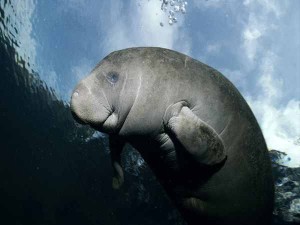
Florida's manatee population – for years a focus of intense conservation efforts and public debate – is healthy and expected to double in the next 50 years, no longer meeting the definition of an endangered species, according to a possible policy-changing conservation study by federal wildlife stewards.
A preliminary five-year status report prepared for the U.S. Fish and Wildlife Service said “threats facing the Florida manatee were less severe than previously thought.” The 23-page analysis by the U.S. Geological Survey included input from the Florida Fish and Wildlife Conservation Commission and Mote Marine Laboratory in Sarasota.
“Our analysis [in 2007] estimated that there was nearly a 9 percent chance of Florida manatee numbers falling below 250 adults over the next 100 years,” said Michael Runge, a USGS research ecologist and lead author of the study. “The current analysis, using data available in 2012, has the estimate dropping to a fraction of 1 percent."
The USGS researchers said the probability of the Florida manatee population falling below 500 adults in the next 150 years was 0.92 percent. Determined conservation efforts were credited. The long-term prospects were also calculated using advances in research, including higher aerial surveys and better tracking, Runge said.
The analysis did not weigh several deadly manatee events since 2012. Runge said "a number of unusual events" since 2009 were not yet part of the analysis, including several cold winters and a die-off because of a severe red tide. Other data also is being studied and an update is expected this year.
“Although the estimated status in 2012 was better than in 2007, questions still remain about the population effects of the more recent cold-related mortality events in the winters of 2009-10 and 2010-11,” Runge said. “The 2012 analysis also does not account for the extensive loss of seagrass habitat in Indian River Lagoon in 2011 and 2012 nor the severe red tide event in the Southwest region of Florida in 2013.”
According to the study, "Under the status quo scenario, the statewide population is expected to increase slowly, nearly doubling over 50 years."
An annual statewide aerial survey by state wildlife officials counted a record 6,063 manatees this year. The news was hailed as a victory for strict, often controversial state and federal conservation measures. Conservation groups and marine mammal experts said it was too early to declare safety in numbers.
"Even though counts are higher, if the quality of [manatees] is compromised in terms of health or reproduction, then long-term trends could take a quick downturn," said Dr. John Reynolds of Mote Marine Laboratory, a former chairman of the Marine Mammal Commission. “Do manatees merit downlisting? I stated that I thought so a few years ago. Now I think it may be premature.”
The FWS, under legal pressure from boating and development interests, is expected to rule on the endangered status of manatees by July.
The FWS listed the manatee as endangered in 1967 and the Endangered Species Act was adopted in 1973.
Outside
Bitcoin mining emissions in China will hit 130 million tonnes by 2024 https://t.co/w6He7so8N2 pic.twitter.com/qYUDtBdeRK
— New Scientist (@newscientist) April 9, 2021
The Gunk Report
For the Blue-Green Algal Bloom Weekly Update from the Florida Department of Environmental Protection, tap here. For DEP's Algal Bloom Sampling Map, tap here.
What, me worry?
» "PLAYING WITH SHARKS," which recently premiered at the Sundance Film Festival, documents diving legend Valerie Taylor.